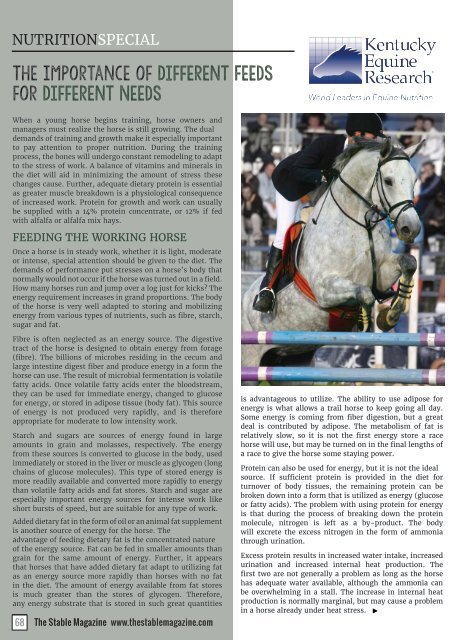The Stable Magazine - April 2016
Australia’s FREE Online Horse Magazine! Read every issue of The Stable FREE online at www.thestablemagazine.com!
Australia’s FREE Online Horse Magazine!
Read every issue of The Stable FREE online at www.thestablemagazine.com!
Create successful ePaper yourself
Turn your PDF publications into a flip-book with our unique Google optimized e-Paper software.
NUTRITIONSPECIAL<br />
<strong>The</strong> Importance of Different Feeds<br />
for Different Needs<br />
When a young horse begins training, horse owners and<br />
managers must realize the horse is still growing. <strong>The</strong> dual<br />
demands of training and growth make it especially important<br />
to pay attention to proper nutrition. During the training<br />
process, the bones will undergo constant remodeling to adapt<br />
to the stress of work. A balance of vitamins and minerals in<br />
the diet will aid in minimizing the amount of stress these<br />
changes cause. Further, adequate dietary protein is essential<br />
as greater muscle breakdown is a physiological consequence<br />
of increased work. Protein for growth and work can usually<br />
be supplied with a 14% protein concentrate, or 12% if fed<br />
with alfalfa or alfalfa mix hays.<br />
FEEDING THE WORKING HORSE<br />
Once a horse is in steady work, whether it is light, moderate<br />
or intense, special attention should be given to the diet. <strong>The</strong><br />
demands of performance put stresses on a horse’s body that<br />
normally would not occur if the horse was turned out in a field.<br />
How many horses run and jump over a log just for kicks? <strong>The</strong><br />
energy requirement increases in grand proportions. <strong>The</strong> body<br />
of the horse is very well adapted to storing and mobilizing<br />
energy from various types of nutrients, such as fibre, starch,<br />
sugar and fat.<br />
Fibre is often neglected as an energy source. <strong>The</strong> digestive<br />
tract of the horse is designed to obtain energy from forage<br />
(fibre). <strong>The</strong> billions of microbes residing in the cecum and<br />
large intestine digest fiber and produce energy in a form the<br />
horse can use. <strong>The</strong> result of microbial fermentation is volatile<br />
fatty acids. Once volatile fatty acids enter the bloodstream,<br />
they can be used for immediate energy, changed to glucose<br />
for energy, or stored in adipose tissue (body fat). This source<br />
of energy is not produced very rapidly, and is therefore<br />
appropriate for moderate to low intensity work.<br />
Starch and sugars are sources of energy found in large<br />
amounts in grain and molasses, respectively. <strong>The</strong> energy<br />
from these sources is converted to glucose in the body, used<br />
immediately or stored in the liver or muscle as glycogen (long<br />
chains of glucose molecules). This type of stored energy is<br />
more readily available and converted more rapidly to energy<br />
than volatile fatty acids and fat stores. Starch and sugar are<br />
especially important energy sources for intense work like<br />
short bursts of speed, but are suitable for any type of work.<br />
Added dietary fat in the form of oil or an animal fat supplement<br />
is another source of energy for the horse. <strong>The</strong><br />
advantage of feeding dietary fat is the concentrated nature<br />
of the energy source. Fat can be fed in smaller amounts than<br />
grain for the same amount of energy. Further, it appears<br />
that horses that have added dietary fat adapt to utilizing fat<br />
as an energy source more rapidly than horses with no fat<br />
in the diet. <strong>The</strong> amount of energy available from fat stores<br />
is much greater than the stores of glycogen. <strong>The</strong>refore,<br />
any energy substrate that is stored in such great quantities<br />
68<br />
<strong>The</strong> <strong>Stable</strong> <strong>Magazine</strong> www.thestablemagazine.com<br />
is advantageous to utilize. <strong>The</strong> ability to use adipose for<br />
energy is what allows a trail horse to keep going all day.<br />
Some energy is coming from fiber digestion, but a great<br />
deal is contributed by adipose. <strong>The</strong> metabolism of fat is<br />
relatively slow, so it is not the first energy store a race<br />
horse will use, but may be turned on in the final lengths of<br />
a race to give the horse some staying power.<br />
Protein can also be used for energy, but it is not the ideal<br />
source. If sufficient protein is provided in the diet for<br />
turnover of body tissues, the remaining protein can be<br />
broken down into a form that is utilized as energy (glucose<br />
or fatty acids). <strong>The</strong> problem with using protein for energy<br />
is that during the process of breaking down the protein<br />
molecule, nitrogen is left as a by-product. <strong>The</strong> body<br />
will excrete the excess nitrogen in the form of ammonia<br />
through urination.<br />
Excess protein results in increased water intake, increased<br />
urination and increased internal heat production. <strong>The</strong><br />
first two are not generally a problem as long as the horse<br />
has adequate water available, although the ammonia can<br />
be overwhelming in a stall. <strong>The</strong> increase in internal heat<br />
production is normally marginal, but may cause a problem<br />
in a horse already under heat stress. >


